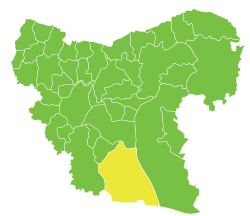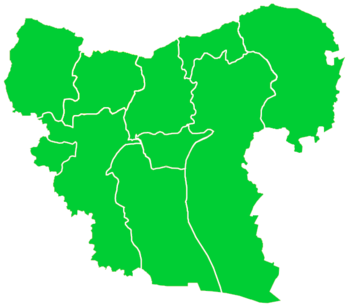Khanasir
| Khanasir خناصر | |
|---|---|
 Khanasir Location in Syria | |
| Coordinates: 35°47′0″N 37°29′50″E / 35.78333°N 37.49722°ECoordinates: 35°47′0″N 37°29′50″E / 35.78333°N 37.49722°E | |
| Country |
|
| Governorate | Aleppo |
| District | Al-Safira |
| Subdistrict | Khanasir |
| Population (2004 census) | |
| • Total | 2,397 |
| Time zone | EET (UTC+2) |
| • Summer (DST) | EEST (UTC+3) |
| Area code(s) | Country code: 963 |
Khanasir (Arabic: خناصر / ALA-LC: Khanāṣir),[1] also spelt Khanaser, is a town located in Syria's as-Safira District. It is one of twenty-four towns and villages located in the Khanasir valley, an area with a population of 11,000 people.[2]

The town is situated on the site of the ancient village of Anasartha, enclosed within ramparts in western Syria; Malalas records that it was a kastron (fortified hilltop settlement) that was designated a polis by the Byzantine emperor Justinian I.[3] A qanat dating back to Byzantine times that served as the water source for the village remained operational well into the 20th century. According to Robert L. France, Byzantine-era remains of Anasartha "are visible on the street, in newly built walls, and inside residential houses," in Khanasir today.[4]
History
The city of Anasartha, which belonged to the Roman province of Syria Prima, and its surrounding villages enjoyed a period of prosperity between the late 4th century and early 6th century. The vast majority of the houses and churches discovered in this region are of that period. The church in Anasartha itself dates from 426.[3]
Its bishop Maras took part in the Council of Chalcedon in 451, and his successor Cyrus was a signatory of the letter that the bishops of the province sent in 458 to the Byzantine Emperor Leo I the Thracian to protest about the killing of Proterius of Alexandria.[5][6]
Another bishop built a "refuge" in neighbouring Buz al-Khanzir in 506-507.[7]
No longer a residential bishopric, Anasartha is today listed by the Catholic Church as a titular see.[8]
While the qanat ceased to supply water to the village after the construction of pump wells in the area west of the Khanasir valley in 1975, the 12.0 km (7.5 mi)-long structure was described by Hamidé in 1959 as discharging 8 litres per second, irrigating a land area of 0.15 km2 (37 acres).[4]
Epigraphic artifacts
Anasartha is the site of a number of inscriptions into stone, or epigraphs. For example, there is an inscription dated to 425 which marks the burial place of Queen Mavia, the leader of Tanukh tribal confederation who mounted a revolt against Roman rule in the late 4th century.[9] Inscriptions dating to the late 6th and early 7th centuries include one on a lintel which reads:
By the gifts of (his) majesty (the) city, despising the inroad of the barbarians, set up at its gates its benefactors, (the) Saviour Christ, (her) gloriously victorious sovereigns, (the) renowned (commander), the prefects of the praetorium, also ? its most holy bishop, (and the?) most glorious engineer, in the month Gorpieos (September), in the 906th (?) year, indiction 13. + Jesus Christ, Emmanuel. + God over all.[10]
Another inscription found on the gate to the city, reads:
+ (Phocas) and Leontia, our most pious sovereigns, O Lord protect! + A pious branch that sprang from noble stock, Gregory, the renowned, and adorned with the fruits of his virtue, presented to God this wall also, in sparing his own country (the expense). Indiction 8, in the 916th year.[10]
Geoffrey Greatrex and Samuel N. C. Lieu write that building work continued in Anasartha in the seventh century and that these epigraphs provide evidence of Roman resistance to Persian invasions.[10]
Reestablishment
At the turn of the 20th century,[11] Circassian immigrants from Manbij,[12] northeast of Aleppo, settled in Khanasir, using old building materials from the site to reestablish the town.[11]
Syrian Civil War
On 23 February 2016, the Syrian Observatory for Human Rights reported that ISIL had captured the town which is located along a major road and supply route to the city of Aleppo. Two days later, the Syrian Army managed to recapture the town back from ISIL.
Climate
A marginal dryland environment, the rainy season in Khanasir falls between October and May with an average annual rainfall of 210 millimetres. Variability between years is high, with 50% of the years between 1929 and 2004 receiving over 200.0 mm (7.87 in), and 25% receiving over 250.0 mm (9.84 in).
July and August are the hottest months with an average daily maximum temperature of 37 °C (99 °F). The lowest average daily minimum temperature is 2.3 °C (36.1 °F) in January. While the temperature can fall below 0 °C (32 °F) at night in November and December, it hardly ever remains that low throughout the day.[13]
Economy
Like the rest of the villagers of the Khanasir valley, those living in Khanasir derive their income from diverse sources, with the majority working either as agriculturalists, pastoralists, or land-poor labourers.[13] Agriculturalists make a per capita income of US$1.30 to $2 per day, supplementing their income from the growing of crops with the fattening of animals and waged labour. Some 40% of the residents of the Khanasir valley are agriculturalists and this sub-section of the population comprises the major land-owning group in the area. Pastoralists and herders migrate, earning a per capita income of $1 to 1.50 per day and often take up fattening to supplement their incomes. Land-poor labourers own some land, between 0.035 km2 (8.6 acres) and 0.07 km2 (17 acres), but make their income by working on the land of others, earning less than $1 per day.[13]
References
- ↑ France, 2007, p. 243.
- ↑ T.L. Nielsen and M.A. Zöbisch (30 May 2001). "Multi-factorial causes of land-use change: land-use dynamics in the agropastoral village of Im Mial, northwestern Syria". Land Degradation & Development. John Wiley & Sons. 12 (2): 143–161. doi:10.1002/ldr.445.
- 1 2 Kennedy, 2006, p. 165.
- 1 2 France, 2007, p. 244.
- ↑ Michel Lequien, Oriens christianus in quatuor Patriarchatus digestus, Paris 1740, Vol. II, coll. 787-788
- ↑ Siméon Vailhé, v. Anasartha, in Dictionnaire d'Histoire et de Géographie ecclésiastiques, vol. II, Paris 1914, col. 1439
- ↑ Kennedy, 2006, p. 166.
- ↑ Annuario Pontificio 2013 (Libreria Editrice Vaticana 2013 ISBN 978-88-209-9070-1), p. 832
- ↑ Ball, 2001, pp. 98–102.
- 1 2 3 Greatrex and Lieu, 2002, pp. 244, 245.
- 1 2 Burns, 2009, p. 175.
- ↑ Musil, 1928, p. 203.
- 1 2 3 International Center for Agricultural Research in Dry Areas (ICARDA) & The Atomic Energy Commission of Syria (AECS) (January 2005). "Sustainable Agricultural development for Marginal Dry Areas: Khanasser Valley Integrated Research Site" (PDF). ICARDA. Archived from the original (PDF) on September 27, 2006.
Bibliography
- Burns, Ross (2009). The monuments of Syria: a guide. I. B. Tauris. ISBN 1845119479.
- Ball, Warwick (2001). Rome in the East: The Transformation of an Empire. Routledge. ISBN 0-415-11376-8.
- France, Robert L (2007). Handbook of Regenerative Landscape Design. CRC Press. ISBN 0-8493-9188-1, ISBN 978-0-8493-9188-0.
- Greatrex, Geoffrey and Samuel N. C. Lieu (2002). The Roman Eastern Frontier and the Persian Wars. Routledge. ISBN 0-415-14687-9, ISBN 978-0-415-14687-6.
- Kennedy, Hugh (2006). The Byzantine and Early Islamic Near East. Ashgate Publishing, Ltd. ISBN 0-7546-5909-7, ISBN 978-0-7546-5909-9.
- Musil, Alois (1928). Palmyrena: A Topographical Itinerary. American Geographical Society.

